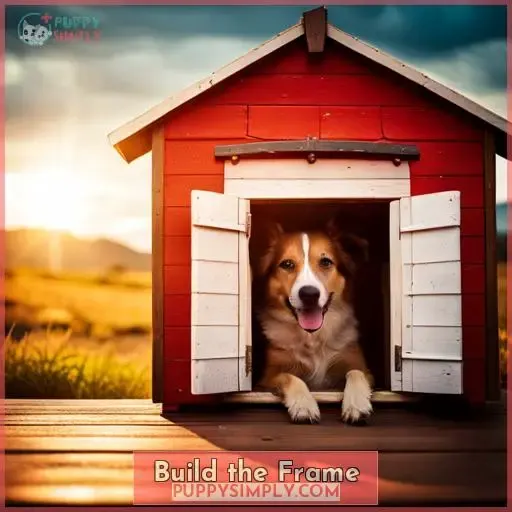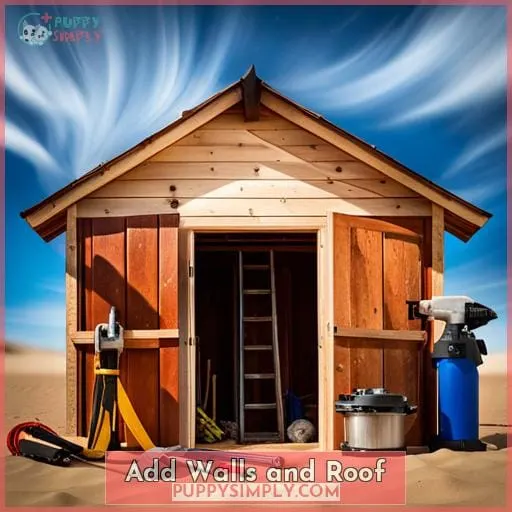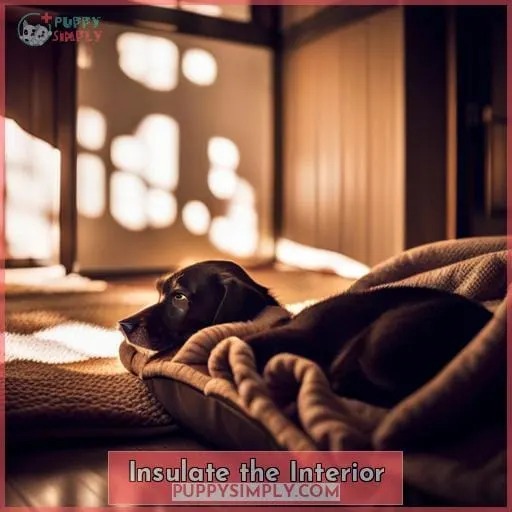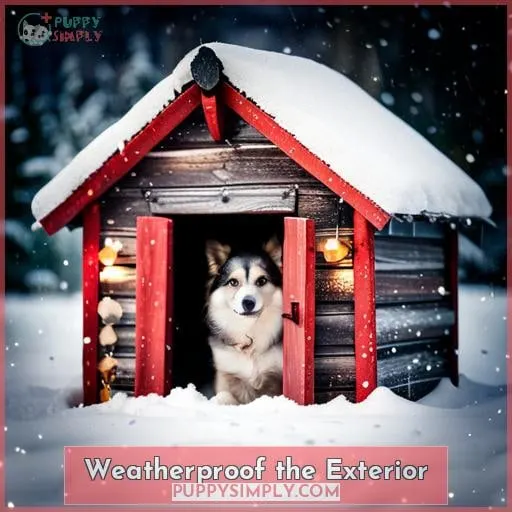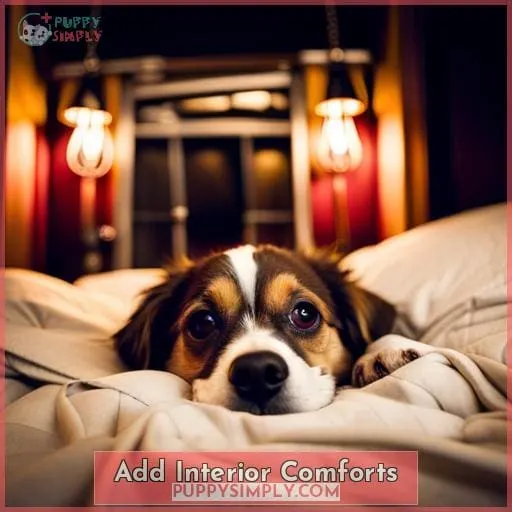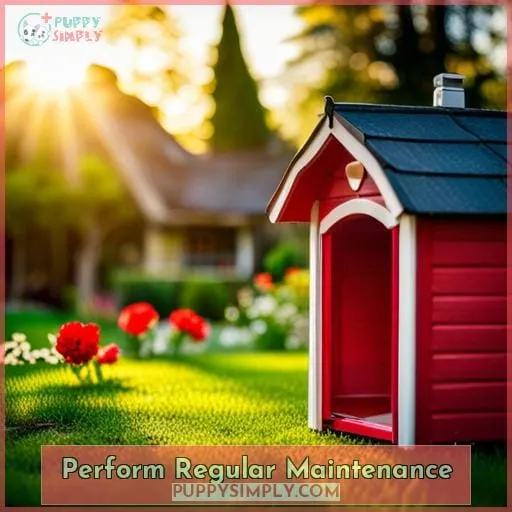This site is supported by our readers. We may earn a commission, at no cost to you, if you purchase through links.
 Measure your dog and prepare to build a cozy, custom dog house.
Measure your dog and prepare to build a cozy, custom dog house.
Choose a dry, accessible location with shade and drainage.
Build a sturdy frame using pre-drilled 2x4s for the base and walls.
Add insulation, plywood, a slanted roof, door, windows, weatherproofing, and interior comforts.
Customize with your pup’s personality to create their perfect, safe haven and fur-free home.
Table Of Contents
Key Takeaways
- Select a location with good sun exposure, drainage, accessibility, and shade.
- Build a sturdy base and frame using properly leveled and secured 2x4s.
- Add insulated walls and roof while weatherproofing all surfaces.
- Install door, window, and draft protection before decorating and adding interior comforts.
Choose the Location
When selecting the spot for your dog’s house:
- Consider sun exposure throughout the day and ensure some shade coverage.
- Check that the ground has good drainage and remains relatively dry to prevent moisture damage.
- Choose an accessible location that allows convenient access for regular cleaning and maintenance.
Sun Exposure and Shade
When choosing where to place your dog’s house, you’ll want to consider the sun’s position so your pooch has both sunlight and shade.
Optimal sun exposure allows periodic sunbathing while also providing retreats from the midday heat.
As you scout locations, note the sun’s arc and resulting patterns of light and shadow.
Target partly-shaded spots that receive gentle morning sun yet become shadier as the day grows hotter.
With smart shade planning, your canine companion can safely relax outside in shady comfort.
Drainage and Dry Ground
You’ll want to select an area with good drainage and dry ground for your dog’s optimal comfort.
Create a gravel bedding beneath the floor of the dog house to allow water drainage and prevent moisture buildup.
If the area is prone to puddling, consider drainage solutions like digging trenches or elevating the ground level.
Sand flooring can also help absorb excess moisture while providing comfort underfoot.
Incorporate moisture prevention measures early in your dog house plans to ensure your pup stays cozy and dry.
Accessibility for Cleaning
You’ll also want to place the dog house where you can easily access it for regular cleaning and maintenance.
Opt for a design with removable panels or sliding walls to simplify access to the interior.
Consider installing a hinged roof panel to conveniently reach inside for cleaning.
Place the structure in an open area without obstructing landscape features to enable full access around the perimeter.
Modular builds allow you to fully disassemble sections for thorough cleaning behind walls.
Prioritize cleaning access when selecting the location to maintain your pup’s creature comforts.
Prepare the Base
For the base, you’re cutting two 22 1/2-inch and two 23-inch pieces of 2×4 wood.
Screw them together to form a level, sturdy platform.
Opt for pressure-treated lumber to resist rotting.
Arrange the boards in a rectangular shape and test for levelness before permanently attaching with 3-inch galvanized screws, drilling pilot holes first.
The galvanization ensures long-lasting rust protection.
Stagger the boards and countersink the screws for maximum stability.
Apply weatherproof wood glue between pieces too.
Extending the front and back boards slightly longer structurally reinforces the base to prevent sagging under your dog’s weight when they enter and exit.
This durable construction establishes a sound foundation upon which to build upwards.
Build the Frame
After assembling the base, construct the frame using properly measured and cut two-by-four wood boards attached with galvanized screws.
Carefully measure and cut two 24-inch and two 30-inch boards.
Assemble them into a rectangular frame using corner joints, ensuring the corners are square.
Drill pilot holes to prevent the wood from splitting.
Secure the joints by driving 3-inch screws at an angle through the corners.
For stability, place a screw every 16 inches along the boards.
Use metal L-brackets on the inside and outside corners for reinforcement.
Check that the frame is completely level in all directions.
Once assembled tightly, the frame provides the structural integrity needed before adding walls and a roof.
With a solid frame in place, focus on decorative finishes to make it pleasing to the eye.
Add Walls and Roof
- Cut plywood sheets to size for the walls and roof.
Screw them into place on the frame.
Use half-inch plywood for adequate strength and rigidity.
Carefully measure and cut the sheets to fit snugly to the frame.
Pre-drill pilot holes in the corners to prevent the plywood from cracking.
Use two-inch weatherproof screws placed every 12 inches around the perimeter to securely fasten the walls in place.
For added protection, apply a bead of silicone caulk between the plywood and framing before screwing it down.
Cut the roof panels slightly larger to overhang the walls and provide shade.
Stain or paint the exterior walls with aesthetic colors that accent your home.
For interior wall décor, consider decals, a chalkboard for notes, or removable wallpaper to periodically change the look.
Insulate the Interior
Once you’ve added the walls and roof, you’ll want to insulate the interior to help regulate temperature and keep your dog comfortable.
Start by cutting foam insulation boards to fit snugly along the walls and ceiling, then secure them in place with adhesive spray before covering the insulation with plywood or panels.
Adding a carpet or soft floor covering over the plywood completes the cozy interior.
Use rigid foam insulation boards rated for exterior use.
Cut boards to fit tightly against interior walls and ceiling.
Secure boards with adhesive spray designed for foam insulation.
Finish by covering insulation with plywood or paneling.
Adding some cozy touches like carpet or cushions will keep your canine companion warm and comfortable all year round.
Proper insulation paired with heating options like heated dog beds or floor mats will winterize your dog’s home.
Ventilation is also key – be sure to allow airflow so the interior doesn’t get too hot in summer or succumb to moisture damage.
With smart insulation strategies, you can soundproof your dog’s house and give them a quiet, peaceful place to call their own.
Weatherproof the Exterior
After insulating the interior to keep your dog comfortable in cold weather, it’s time to weatherproof the exterior.
To transition smoothly between topics, we’ll briefly recap insulating the inside before moving on.
With a cozy interior taken care of, let’s shift focus to fortifying the outside against wind, rain, and temperature swings. This critical step protects your efforts thus far and ensures your doghouse withstands seasons outdoors.
When weatherproofing, first prepare surfaces by scraping, sanding, and cleaning.
Next, apply two coats of high-quality exterior paint or stain using techniques like brushing evenly and sanding lightly between coats.
Top with a durable waterproof sealant around all seams and edges. Reapply seals annually.
Additionally, decorative touches like shingles, faux stonework, or artistic paint can make your doghouse as cute as your canine companion.
With some creativity, their new home can be stylish and protected.
Install Door and Windows
You’ll want to measure and cut an opening for the door and windows once the walls and roof are in place.
Consider hinged or sliding windows to allow adjustable ventilation.
Install a rubber flap over the door entrance to prevent drafts while allowing easy access.
Apply weatherstripping around windows and doors to protect from moisture.
Add plexiglass panels over openings for light while blocking wind and rain.
When installing the door and windows, tailor the styles and weatherproofing techniques to suit your climate.
Proper lighting and ventilation will keep your canine comfortable in their new custom sanctuary.
With thoughtful design choices, you can create an enduring shelter against the elements.
Add Interior Comforts
After installing the door and windows to allow ventilation and light, it’s time to focus on creating a cozy interior for your canine companion.
Provide a snug hideaway using plush bedding materials.
Layer the floor with cedar chips or straw bedding for additional warmth.
Add an elevated cot or orthopedic foam bed for joint relief and extra insulation.
Drape a fleece blanket over the doorway or cover the roof’s underside to buffer drafts.
Include a hydration station with a no-spill bowl kept filled with fresh, clean water.
Create a meal nook by affixing a food dish in the corner. This dedicated dining area prevents scattering kibble across their nesting space.
Lastly, incorporate playful toys like rope pulls, chew bones, treat balls, and squeaky stuffies.
With comforts for sleeping, playing, eating, and drinking, their new custom cottage offers a cozy canine retreat.
Decorate the Exterior
You’ll personalize its appearance once you decorate the dog house’s exterior to match your home.
Consider painting colorful murals that reflect your pup’s spirited personality or showcase scenic landscapes.
Install a customized nameplate displaying your dog’s name over the doorway to give it a homey feel.
Embellish the sides with nature-themed designs, like handpainted flowers or trees.
For visual interest, apply mosaic tile accents along the edges of the roof or around the entrance.
Change up the look seasonally if desired, decorating for holidays with wreaths, lights, or banners.
Customizing the décor makes it your dog’s special retreat.
Perform Regular Maintenance
Inspect your dog’s house regularly for damage or wear that needs repairing.
Examine the walls, roof, floors, and corners for cracks, leaks, rot, or instability.
Make repairs promptly with exterior-grade lumber, plywood, waterproof sealant, galvanized screws, and roofing materials to prevent further deterioration.
Sweep out dirt and debris weekly to prevent accumulation.
Scrub the floors and walls as needed using gentle pet-safe cleaners.
Renew weatherproofing sealants every couple of years to protect from moisture damage.
Do seasonal inspections to ensure proper ventilation in summer and warmth in winter by adjusting or installing flaps, windows, insulation, and bedding.
Maintaining your dog’s house preserves its safety, longevity, and coziness.
Frequently Asked Questions (FAQs)
What are some good insulation materials to use?
Use rigid foam boards or spray foam for insulation. They have high R-values for efficiency.
Make sure to cover with plywood so the dog can’t chew and ingest it, as some types may be toxic if consumed.
Proper insulation helps regulate temperature.
Should I elevate the dog house off the ground and if so, how?
Yes, elevate it to prevent water damage and pests.
Set it on cinder blocks or bricks with spacers to allow airflow underneath.
Ensure it’s high and wide enough for easy entry and exit.
A ramp can aid accessibility.
What is the ideal door size for my dog?
The height of your dog’s shoulder determines the ideal dog house door size.
Calculate the height at the tallest point of the shoulder.
Add 4 inches for dogs under 30 pounds or 7 inches for larger breeds like Beagles.
Customize for each pet’s size, allowing room to enter and exit comfortably.
What kind of flooring works best?
Use padded indoor/outdoor carpeting for warmth and traction.
Avoid gravel or sand which can irritate paws.
Ensure the carpeting is water resistant and removable for easy cleaning.
Are there any safety concerns I should be aware of when building?
When choosing materials, opt for non-toxic and chew-resistant options.
Ensure proper ventilation.
Avoid small décor that could pose choking hazards.
Prioritize stability and reinforce joints to prevent collapse.
Though tempting, skip the luxury spa – hot tubs and your pup don’t mix.
Focus on function over flare for Fido’s safety.
Conclusion
After setting up this cozy new space, your faithful companion will excitedly call their customized doghouse home.
Maintaining your canine’s perfect haven ensures lasting enjoyment while bringing you both peace as the relaxing spot shelters your pup.
House How to Build a Dog House Guide builds durable sanctuaries made to measure for furry friends.
Proper care protects your pet palace investment to provide endless dog days of simple summer fun or full days of winter rest.



